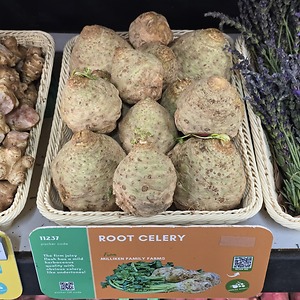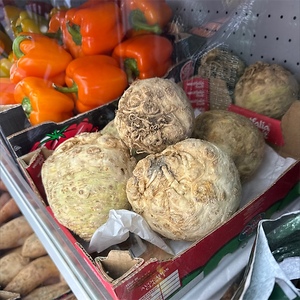


Celery Root (Celeriac)
Estimated Inventory, 12 ct : 7.00
This item was last sold on : 07/02/25
Description/Taste
Celery Root varies in size and shape depending on growing conditions and averages 10 to 14 centimeters in diameter in commercial markets. The swollen stems have a globular, oblate, or irregular shape and are often covered in roots, nodes, crevices, and rough patches. The gnarled stem has a tough, textured, and thick exterior, appearing in shades of brown, green, and white. Underneath the stem’s surface, the ivory-to-white flesh is dense, solid, and firm. The flesh browns quickly after slicing and needs to be treated to retain its bright nature. When raw, Celery Root has a crisp, crunchy, and succulent consistency. The texture is said to be less starchy than a potato and less watery than a jicama. Once cooked, the flesh softens and develops a smooth and tender mouthfeel. Celery Root emits an herbal, earthy, and nutty aroma with celery-like notes. The stem is edible raw or cooked and has a mild, subtly sweet, nutty, and vegetal taste with celery and parsley nuances. In some markets, Celery Root is sold with its leafy stemmed tops still attached. These tops are thin and also edible, typically chopped and lightly cooked in recipes. The greens will have a flavor reminiscent of common celery.
Seasons/Availability
Celery Root is available year-round, with a peak season in the fall through early spring. In professional storage, Celery Root can last for 6 to 8 months after harvest.
Current Facts
Celery Root, botanically classified as Apium graveolens var. rapaceum, is a bulbous, swollen stem base cultivated for culinary use, belonging to the Apiaceae family. The leafy plant is slow maturing, taking 90 to 200 days to develop, and produces upright, leafy stalks on top of a firm and fleshy stem base known as a hypocotyl. Despite its name, Celery Root is not a true root and is also known by other descriptors, including Celeriac, Knob celery, and Turnip-Rooted celery. It is important to note that Celery Root differs from the green-stalked celery sold in commercial markets. Both vegetables belong to the same species but are separate varieties. Celery Root is a cool-weather plant grown worldwide and has been cultivated as a culinary ingredient for centuries. The variety is well-known in Europe and parts of Asia, and chefs and home cooks utilize Celery Root raw or cooked in a wide array of savory dishes.
Nutritional Value
Celery Root is a source of fiber to cleanse and regulate the digestive tract and vitamins C, B, and K to strengthen the immune system while aiding the body in faster wound healing. Celery Root also provides minerals like phosphorus, calcium, potassium, iron, magnesium, and manganese. Phosphorus and calcium protect bones and teeth, while potassium balances fluid levels within the body. Iron develops the protein hemoglobin for oxygen transport through the bloodstream, magnesium controls nerve functions, and manganese supports metabolism.
Applications
Celery Root has a fresh, nutty, earthy, and herbal taste suited for raw and cooked preparations. The swollen stems must be washed and peeled before use to remove excess dirt and tough skin. Once prepped, Celery Root can be finely sliced or chopped and added to salads. The cut pieces must be soaked in acidulated water to prevent the flesh from browning. Celery Root is used throughout Europe in slaws, green salads, and crunchy side dishes. It can also be grated and stirred into dips. In addition to fresh preparations, Celery Root is favored cooked and commonly boiled, mashed, stewed, roasted, and blanched. The stems can be sliced and roasted with salt and fresh herbs as a simple side dish or cooked in casseroles and gratins. Celery Root is also famous for pureeing into soups or as a flavoring base for high-end meals. Try using Celery Root as a non-starchy substitute for potatoes in recipes. Celery Root is also boiled or baked into chips. In France, Celery Root is frequently simmered into soups and stews. In Germany, it is a favored side dish ingredient and is occasionally used in soups and schnitzels. Vegetarians also cook Celery Root whole and cover the surface in spices and marinades to create meatless dishes. Beyond fresh dishes, Celery Root is dried and ground into a flaky spice. This spice can be used over casseroles, meat dishes, stuffings, and salads. Celery Root pairs well with herbs such as rosemary, cilantro, and parsley, cheeses including gruyere, feta, and blue, toasted walnuts, and fruits such as pears, figs, and apples. Whole, unwashed, and unpeeled Celery Roots will last several weeks when stored in a paper towel in an unsealed bag in the refrigerator’s crisper drawer. Celery Root can also be blanched and frozen for extended use.
Ethnic/Cultural Info
Celery Root is primarily known as Celeriac in France and is famous for its use in a raw dish called céleri rémoulade, or celery remoulade. The history of remoulade is allegedly tied to the Picardy region in northern France and was first described in cookbooks in the early 18th century. The name remoulade is thought to be derived from either “remoudre or remoulu,” meaning “ground twice” or “reground,” or “remola or ramolos,” meaning “horseradish.” Despite the etymological discrepancies, celery remoulade is traditionally comprised of shredded Celery Root tossed in a Dijon-mustard and mayonnaise-based dressing. The dish is served chilled and raw, and additional flavorings like capers, parsley, tarragon, apples, or cornichons are added. Since its creation, celery remoulade has been widely found on menus across France and is also customarily made at home as a light appetizer. In the early 21st century, a Celery Remoulade World Cup competition was also established and held in France to honor the favored dish. During the competition, chefs had twenty minutes to prepare their own creative versions of celery remoulade, incorporating new ingredients. The dish was later judged by a jury panel of culinary experts, who awarded the winning plate trophies and prizes.
Geography/History
Celery Root is a descendant of a wild species that was cultivated over time to become the varieties found within Apium graveolens. Wild versions of Celery Root have been naturally growing in marshlands since ancient times and are thought to be native to areas of the Mediterranean, Middle East, and North Africa. Much of the history of how the wild species was transformed into Celery Root is unknown, but Apium graveolens, as a species overall, was cultivated in ancient empires including Greece, Egypt, and Rome. Celery Root was eventually spread into northern Europe, and as the swollen stems were developed and grown to larger sizes, their use expanded as a culinary ingredient. The variety also became a delicacy in parts of the Middle East during the 16th century and was a culinary ingredient in France by the 17th century. Later in the 18th century, Celery Root was commercially produced on a larger scale across Europe, the Middle East, and Asia. It was also introduced to North America in the 19th century. Today, Celery Root is grown worldwide and is found in select fresh markets, specialty retailers, distributors, and supermarkets.
Featured Restaurants
Restaurants currently purchasing this product as an ingredient for their menu.
| Copper Kings | San Marcos CA | 323-810-1662 |
| Glenbrook Health Center | Carlsbad CA | 760-704-1000 |
| Encontro North Park | San Diego CA | 310-955-6333 |
| Mister A's | San Diego CA | 619-239-1377 |
| PFC Fitness Camp | Carlsbad CA | 888-488-8936 |
| The Santaluz Club Inc - Banquet | San Diego CA | 858-759-3150 |
| Southwestern Yacht Club | San Diego CA | 619-222-0438 |
| Born & Raised | San Diego CA | 619-944-1631 |
| US Grant Hotel Grill | San Diego CA | 619-232-3121 |
| Jeune Et Jolie | Carlsbad CA | 858-231-0862 |
| Shoreside Support Boat | San Diego CA | 704-277-7929 |
| Bistro du Marche by Tapenade | La Jolla CA | 858-551-7500 |
| C 2 C | San Diego CA | 619-972-9345 |
| Herb & Sea | Encinitas CA | 858-587-6601 |
| Pacifica Del Mar | Del Mar CA | 858-792-0505 |
| Kitchens for Good - Culinary Program | San Diego CA | 619-450-4040 |
| Viejas Casino Grove Steakhouse | Alpine CA | 800-295-3172 |
| Crudo Cevicheria & Oyster Bar | San Diego CA | 619-313-9127 |
| Prager Brothers Artisan Bread | Carlsbad CA | 760-445-9536 |
| Merenda | Oceanside CA | 703-459-4145 |
Recipe Ideas
Recipes that include Celery Root (Celeriac). One

















